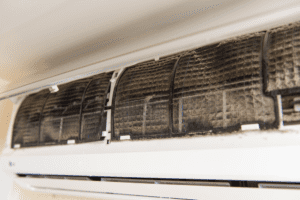Has the air throughout your commercial building started to smell musty and stale? Does the problem worsen every time the air conditioning or heat kicks in? Does the air smell bad coming out of your vents? If you answered ‘Yes’ to any of these questions, then you may require an air duct cleaning for mold.
Mold is not the most common issue in HVAC air ducts. Dust, dirt, dander, and debris are all more likely to end up in your ducts—and circulating throughout your building—than mold or mold spores. With that point made, however, mold growth in commercial air ducts is still a problem that occurs from time to time. Cleaning moldy ducts thoroughly is an important step to restore internal air quality in your building and protect the health of your tenants or employees.
Why Mold Growth Sometimes Occurs in Air Ducts (and How You Can Tell)
 HVAC ducts are more likely to get moldy in warm and humid locations. When cold air passes through the ducts, condensation forms, causing water droplets to collect. Over time, this moisture leads to the formation of mold, helped along by all the other junk—dust, dander, dirt, pollen, dead skin cells, and more—that makes its way into the ducts.
HVAC ducts are more likely to get moldy in warm and humid locations. When cold air passes through the ducts, condensation forms, causing water droplets to collect. Over time, this moisture leads to the formation of mold, helped along by all the other junk—dust, dander, dirt, pollen, dead skin cells, and more—that makes its way into the ducts.
By far, the most obvious sign of mold in your air ducts is the smell. While mold will sometimes be visible in the ducts and around the vents, mold spores themselves are microscopic and invisible to the naked eye. Even if your duct looks largely clean, there could be mold that you’re not seeing. Your nose, though, is unlikely to lead you astray on this front. A mold problem in your ducts—combined with a running HVAC system—will impact the air quality throughout your building. If you start noticing that the air in your building smells musty or stale, then a moldy duct is probably the culprit.
What you should be most concerned about, meanwhile, is what the musty, mildew scent tells you. HVAC ducts are the perfect vehicle to distribute mold spores throughout your building, which people in the building are then inhaling. The inhalation of mold spores on a repeated or consistent basis is a health concern that you need to take seriously. You or others in the building may exhibit numerous symptoms as a result, including:
- Aggravated allergies, resulting in symptoms such as a runny nose, frequent sneezing, scratchy throat, itchy/watery eyes, and even rashes or other skin reactions
- Increased frequency of coughing, sneezing, throat cleaning, or eye irritation, even for those who don’t suffer from any allergies
- Frequent dull headaches that occur indoors but dissipate outside in the fresh air
- Fatigue, dizziness, or even nausea
With moldy ducts, these symptoms are unlikely to be isolated or concentrated among a few specific individuals. On the contrary, you will probably hear complaints about these symptoms from many people who are living or working in your commercial building. While those with severe allergies will be the most bothered, the fact is that mold affects everyone’s respiratory system negatively. Just as everyone will be able to smell the mustiness of the air in your building, everyone will suffer some sort of negative effect of the mold infestation.
When to Call for Air Duct Cleaning for Mold
If you have reached the point where people are complaining about these issues, don’t wait to call and schedule an air duct cleaning for mold. Ideally, you should call your HVAC technician right away when you start to notice a musty smell in your building. At very least, you want to have a professional inspect your ducts and let you know if there is a mold issue at play. Mold is a problem that won’t fix itself, and that will only worsen over time. A thorough, professional cleaning is necessary to get your ducts back to a state where they can deliver clean air throughout your building once more. Even if mold isn’t a problem in your ducts, you may be due for a cleaning just to get rid of dirt, dust, and other debris. Either way, spending a few bucks on a duct inspection is not a bad idea at this juncture.
Cleaning your ducts regularly—whether to remove mold or other debris—will benefit everyone in your building. It will improve the interior air quality and remove allergens from the environment, making building a much healthier place to live, work, or spend time. Businesses, for instance, will benefit from healthier employees, higher productivity, and lower absentee rates. Cleaner ducts also provide a clearer avenue for cold or warm air to get from point A to point B in your building. These clearer thoroughfares improve the efficiency of your HVAC system as a whole, reducing the amount of work the system has to do to maintain thermostat temperatures.
Put simply, air duct cleaning for mold is an essential component of maintaining any commercial building. If you suspect that mold is growing in your ducts, don’t delay in calling for a professional inspection and cleaning service.

